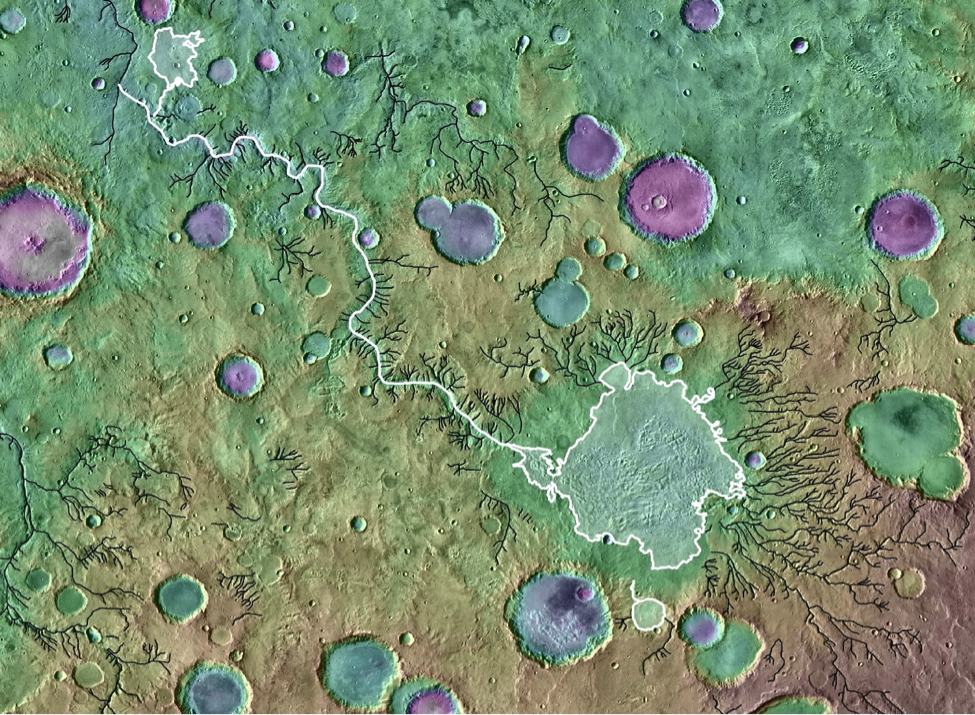

Billions of years ago, the surface of Mars was dotted with massive lakes created when impact craters slowly filled with water. Eventually, many of the lakes burst their bounds, leading to catastrophic floods that gouged canyons into the surrounding landscape.
These short but deep channels may have played an unexpectedly important role in shaping the Red Planet’s topography, scientists reported this week in Nature. The researchers compared satellite imagery of valleys created by overflowing craters and more gradual river erosion across Mars, and found that canyons associated with crater lakes accounted for nearly a quarter of the total volume of the valleys. The findings highlight key differences in the processes that have influenced the landscapes of Earth and Mars, and have implications for understanding our neighbor’s past habitability.
“They aren’t just one-offs that we can mostly ignore at a global scale,” Timothy Goudge, a planetary scientist at the University of Texas at Austin and coauthor of the study. “Recognizing that this is a global process helps inform the way we should think about how Mars’s surface evolved.”
During early, soggier chapters of Mars’s history, crater lakes could reach hundreds of kilometers across, comparable in size to small Earthly seas such as the Caspian. Many of these lakes ultimately became so full that water would spill over the rim of the crater, wearing it down and allowing still more water to escape. In other cases, the flooding began when the immense pressure from all the water stored in the crater ruptured the rim.
All this happened more than 3.5 billion years ago, so it’s difficult to know how rapidly these channels formed, Goudge says. However, he and his colleagues are using computer models to recreate past floods, and suspect they took place over days to weeks.
Mars is also home to branching valley networks that resemble those seen on Earth, which were etched into the ground over tens to hundreds of thousands of years by rivers fed with rainfall or snowmelt. Researchers have typically considered this slow process to be the main way that Martian valleys formed.
[Related: After a few hiccups, NASA’s Perseverance begins its main missions on Mars]
“What we have done in our work is to sort of test that assumption and see, are the catastrophic floods isolated, one-off events, or are they globally important?” Goudge says.
He and his team consulted a map of Martian valleys and determined which ones were created by gradual erosion and which had been fed by crater lakes. The researchers next drew upon elevation data collected by NASA’s Mars Global Surveyor spacecraft to determine the valleys’ depth.
From this information, the team calculated that canyons associated with burst crater lakes added up to a mere 3 percent of the total length of Martian valleys, but accounted for 24 percent of their volume. These channels had been cut deeply into the landscape, with a middle value of 170.5 meters (559.4 feet), more than twice that of the river valleys that formed through gradual erosion. Goudge and his colleagues estimated that the ancient floods had carved out around 14,000 cubic kilometers (3,358.8 cubic miles) of sediment—enough to fill up Lake Superior and Lake Ontario with a little bit left over, he says.
On Earth, influxes of water from melting ice sheets have sometimes caused glacial lakes to overflow and unleash powerful floods, creating landforms like the Channeled Scablands in Washington State. However, Earth’s ever-busy plate tectonics have destroyed many of the impact craters that might otherwise have formed lakes. Mars doesn’t have plate tectonics, so its craters “just sit around,” Goudge says.
“On Earth, these lake breached floods are important during certain time periods, especially these periods of transition,” he says. “What we think for Mars is that they were always important.”
[Related: ‘Robot swarms’ could one day build underground shelters for humans on Mars]
Understanding the Red Planet’s water and climate history is key to figuring out whether it might once have harbored conditions suitable for life. In the future, Goudge and his colleagues plan to investigate which of the floods from breached crater lakes may have been powerful enough to alter the topography of neighboring river valley networks—something that wouldn’t happen much on Earth.
“Comparing the average Martian valley system to the average terrestrial valley system might be more of an apples-to-oranges comparison than we previously thought,” he says. “We need to take into account the unique complexities of Martian topography in order to best understand past environments.”
